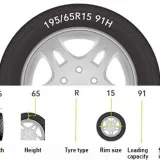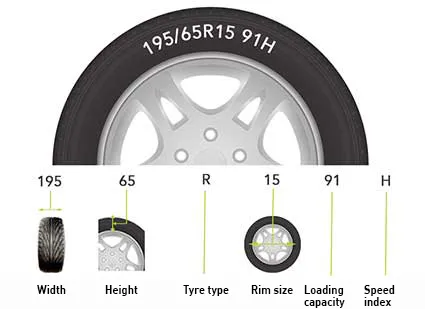Width (e.g., 195)
The first number represents the tire's width. It varies from 125mm to approximately 335mm. Tires increase in width in increments of 10 millimeters. However, special tires for new rim-tire systems may deviate from this. These width measurements range from 160mm to 240mm.
Aspect Ratio (e.g., 65)
The second number indicates the tire's aspect ratio, which is expressed as a percentage of the width. For example, in the tire size 195/65 R 16, the aspect ratio is 65% of the width. In this case, the aspect ratio is 65% of 195mm, which is 126.75mm.
Tire Type (e.g., R)
The 'R' in the tire code stands for 'Radial'. It indicates how the tire is constructed. Radial means that the cords, which form the tire's base, run radially across the tire.
Rim Diameter (e.g., 15)
The third number represents the diameter of the rim. It is measured diagonally and from the rim's edge. Rim diameter is typically expressed in inches. In Europe, most passenger vehicles have rim diameters ranging from 10 to 20 inches.
Load Index (e.g., 91)
The last number, the load index, indicates the tire's load-carrying capacity. The table below shows the corresponding load capacity in kilograms for each code. Tires with a load index of 91 have a load-carrying capacity of 615 kilograms.
Speed Index (e.g., H)
The letter following the load index indicates the tire's speed rating, which can be inferred from the tire size. In the tire size 195/65 R 15 91 H, the speed symbol is H. H represents a speed rating of 210 km/h. This means that the vehicle equipped with this tire should not exceed a speed of 210 km/h.
Tread Direction
Tires with special tread patterns often include a term on the sidewall indicating the tire's rotational direction. This term is accompanied by an arrow indicating the tread's rotational direction. This information is important during tire installation.





